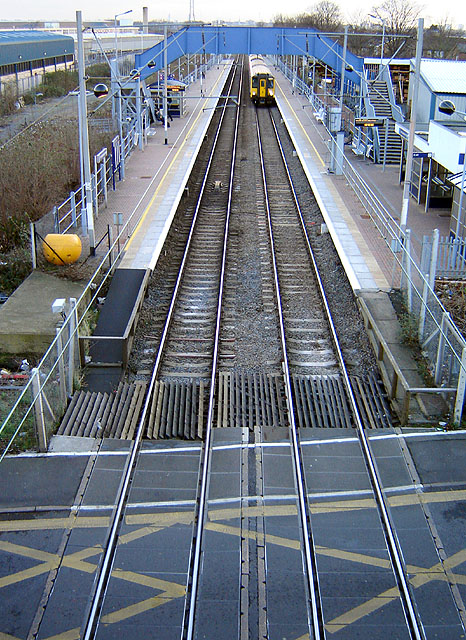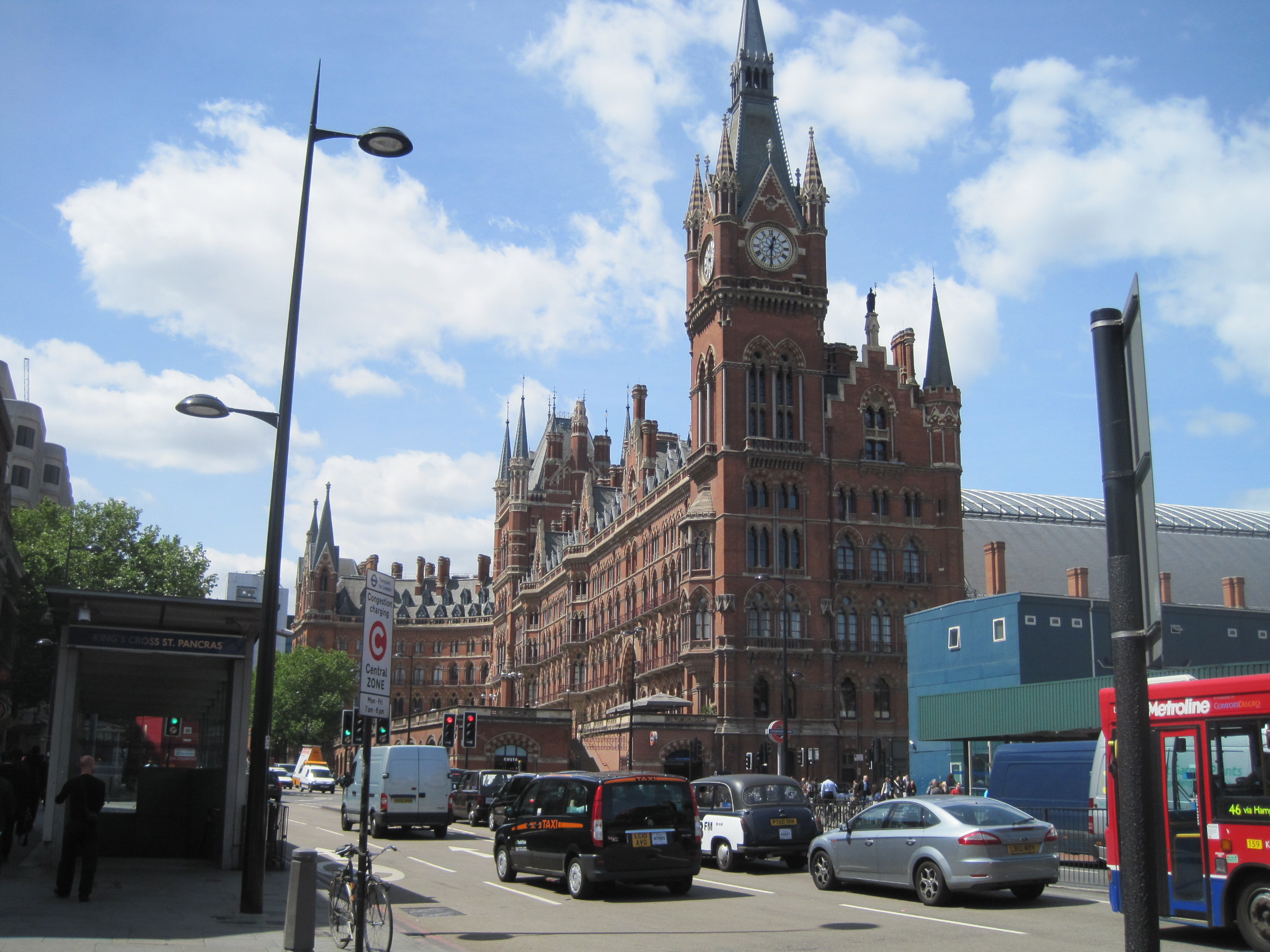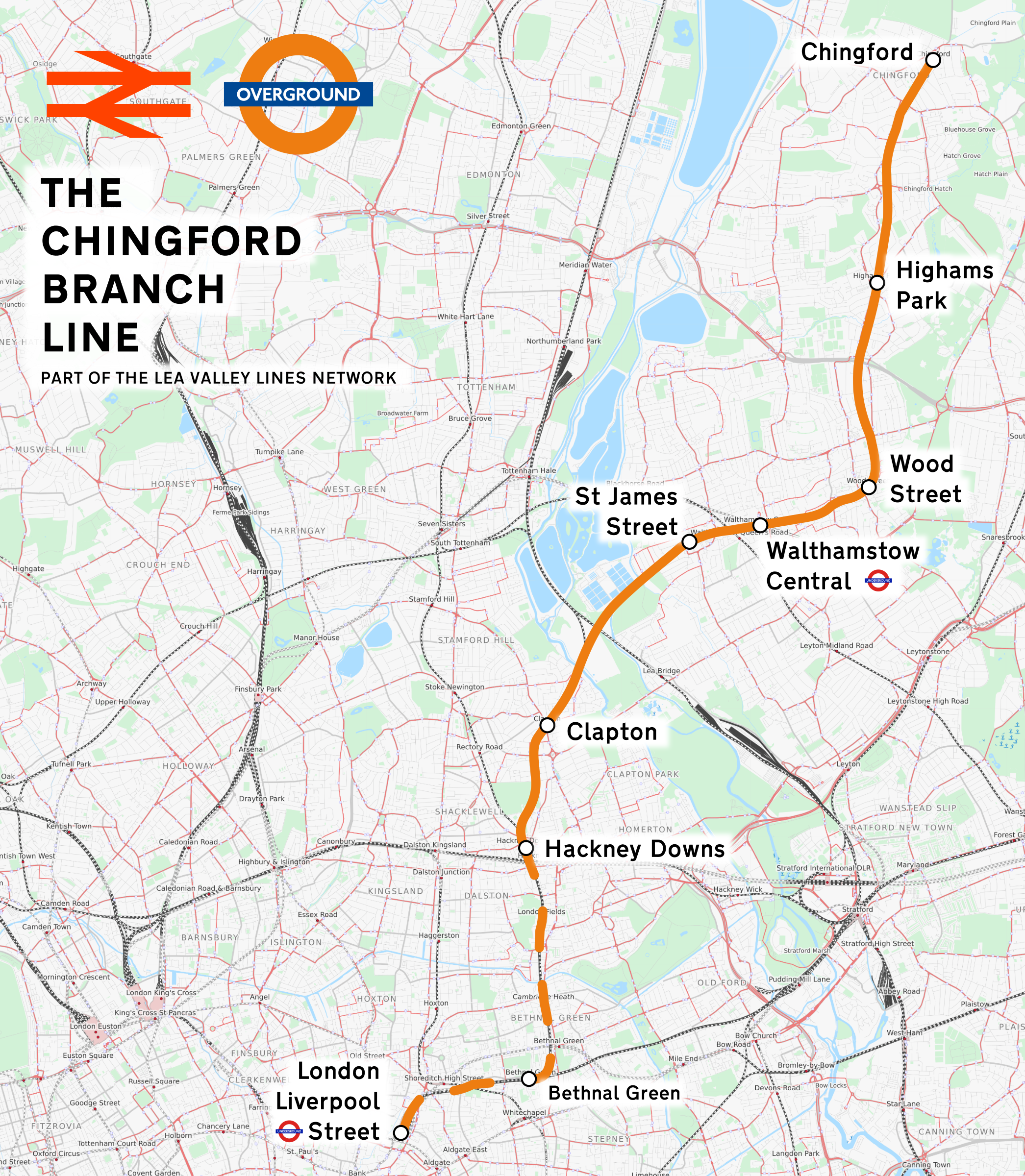|
Northumberland Park Railway Station
Northumberland Park railway station is on the Lea Valley line that forms part of the West Anglia Main Line, serving the ward of Northumberland Park in Tottenham, north London. It is down the line from London Liverpool Street and is situated between and . Its three-letter station code is NUM and it is in Travelcard zone 3. It is one of the stations that can be used to access Tottenham Hotspur Stadium. The station and all trains serving it are operated by Greater Anglia. The station was upgraded starting 2017 to add an extra track and a new island platform. It had one of north London's few level crossings to its immediate north, but this was removed in the rebuilding of the station as a result of the STAR (Stratford to Angel Road) project. Northumberland Park Depot for the London Underground's Victoria line is sited adjacent to the station and it is close to Tottenham Hotspur Football Club. History Northumberland Park was opened on 1 April 1842 as a Halt on the Northern & ... [...More Info...] [...Related Items...] OR: [Wikipedia] [Google] [Baidu] |
Greater Anglia (train Operating Company)
Greater Anglia (legal name Abellio East Anglia Limited) is a train operating company in Great Britain owned as a joint venture by Abellio, the international arm of the state-owned Dutch national rail operator Nederlandse Spoorwegen, and the Japanese trading company Mitsui & Co. It operates the East Anglia franchise, providing the commuter and intercity services from its Central London terminus at London Liverpool Street to Essex, Suffolk, Norfolk and parts of Hertfordshire and Cambridgeshire as well as many regional services throughout the East of England. Abellio began operating the franchise, then known as the Greater Anglia franchise, in February 2012. Initially, it traded under the same name until it rebranded as Abellio Greater Anglia in December 2013. Shortly after taking over operations, the company initiated a series of projects to improve service levels, including the procurement of new trains and the launch of the 'Norwich in 90' programme to reduce travel times ... [...More Info...] [...Related Items...] OR: [Wikipedia] [Google] [Baidu] |
Eastern Counties Railway
The Eastern Counties Railway (ECR) was an English Rail transport, railway company incorporated in 1836 intended to link London with Ipswich via Colchester, and then extend to Norwich and Great Yarmouth, Yarmouth. Construction began in 1837 on the first nine miles at the London end. Construction was beset by engineering and other problems, leading to severe financial difficulties. As a result, the project was truncated at Colchester in 1843 but through a series of acquisitions (including the Eastern Union Railway who completed the link between Colchester and Norwich) and opening of other lines, the ECR became the largest of the East Anglian railways. In 1862 ECR was merged with a number of other companies to form the Great Eastern Railway. Opening In 1835 a surveyor called Henry Sayer presented a plan for a new railway from London to York via Cambridge to London solicitors Dimes & Boyman. Together with John Clinton Robertson who was to become the first secretary of the ECR and e ... [...More Info...] [...Related Items...] OR: [Wikipedia] [Google] [Baidu] |
West Anglia Great Northern
West Anglia Great Northern, commonly shortened to ''WAGN'', was a train operating company in England. It operated the West Anglia Great Northern franchise between January 1997 and March 2004, as well as the Great Northern franchise between April 2004 and March 2006. It was initially owned by Prism Rail, and was subsequently acquired by the British transport conglomerate National Express. The West Anglia Great Northern franchise was created as part of the privatisation of British Rail, the recently-founded company Prism Rail successfully bid for it, being awarded a seven year concession for its operation during December 1996. It took over operations from British Rail on 5 January 1997. The company set about overhauling its inherited rolling stock, such as the Class 313 and Class 317 electric multiple units. By 1999, WAGN was amongst the best performing franchises according to statistics compiled by the Office of Passenger Rail Franchising. However, proposed open access services ... [...More Info...] [...Related Items...] OR: [Wikipedia] [Google] [Baidu] |
Privatisation Of British Rail
The privatisation of British Rail was the process by which ownership and operation of the railways of Great Britain passed from government control into private hands. Begun in 1994, it had been completed by 1997. The deregulation of the industry was initiated by EU Directive 91/440 in 1991, which aimed to create a more efficient rail network by creating greater competition. British Railways (BR) had been in state ownership since 1948, under the control of the British Railways Board (BRB). Under the Conservative government of Margaret Thatcher elected in 1979, various state-owned businesses were sold off, including various functions related to the railways – Sealink ferries and British Transport Hotels by 1984, Travellers Fare catering by 1988 and British Rail Engineering Limited (train building) by 1989. It was under Thatcher's successor John Major that the railways themselves were privatised, using the Railways Act 1993. The operations of the BRB were broken up and sold o ... [...More Info...] [...Related Items...] OR: [Wikipedia] [Google] [Baidu] |
Network SouthEast
Network SouthEast (NSE) was one of the three passenger sectors of British Rail created in 1982. NSE mainly operated commuter rail trains within Greater London and inter-urban services in densely populated South East England, although the network went as far west as Exeter. Before 1986, the sector was originally known as ''London & South Eastern''. During the privatisation of British Rail, it was gradually divided into a number of franchises. History Before the sectorisation of British Rail (BR) in 1982 the system was split into largely autonomous regional operations: those operating around London were the London Midland Region, Southern Region, Western Region and Eastern Region. Sectorisation of BR changed this setup by instead organising by the traffic type: commuter services in the south-east of England, long-distance intercity services, local services in the UK regions, parcels and freight. The aim was to introduce greater budgetary efficiency and managerial accounta ... [...More Info...] [...Related Items...] OR: [Wikipedia] [Google] [Baidu] |
British Rail Brand Names
British Rail was the brand image of the nationalised railway owner and operator in Great Britain, the British Railways Board, used from 1965 until its breakup and sell-off from 1993 onwards. From an initial standardised corporate image, several sub-brands emerged for marketing purposes, and later in preparation for privatisation. These brands covered rail networks, customers services, and several classes of new trains. With the size of British Rail's fleet, due to the time required to repaint rolling stock, in terms of the physical trains brand switchovers could be lengthy affairs lasting years. This worsened into privatisation, with the same services often using 3 or 4 different liveries. Following privatisation, several of the brands disappeared, although some brand names such as ScotRail, Merseyrail, Eurostar and Freightliner still exist today. The double-arrow symbol introduced with the creation of the British Rail brand in the 1960s, still remains after privatisation, ... [...More Info...] [...Related Items...] OR: [Wikipedia] [Google] [Baidu] |
British Rail Class 125
The British Rail Class 125 was a design of three car Diesel Multiple Unit built by BR Derby at Derby Works in 1958. They were almost identical in appearance to the Class 116. History The Class 125 was built in 1958 at Derby Works as high capacity suburban railcars specifically for the Lea Valley Lines near Stratford. They were fitted with powerful Rolls-Royce engines, allowing them to have comparable performance to contemporary EMUs.They bore a close resemblance to the similar class 116, which were also built by British Rail at Derby. The Class 125 had a unique multiple working code (orange star), due to their unique pneumatic, rather than electric, engine control system. They also had a non-standard jumper cable arrangement and were therefore incompatible with other British Rail diesel multiple unit classes. They were withdrawn in 1977 and like many other first generation DMUs, never wore their Class 125 TOPS classifications. Operational history The class 125 entere ... [...More Info...] [...Related Items...] OR: [Wikipedia] [Google] [Baidu] |
Seven Sisters Station
Seven Sisters is a National Rail, London Overground and London Underground Victoria line station in the Seven Sisters area of the London Borough of Haringey, north London. The station has two entrances/exits, one on Tottenham High Road and the other on Seven Sisters Road. The station is in Travelcard Zone 3. Seven Sisters lies between Finsbury Park and Tottenham Hale on the Victoria line and between Stamford Hill and Bruce Grove on the Lea Valley Cheshunt/Enfield Town Line from Liverpool Street, operated by London Overground. Abellio Greater Anglia also serve at peak times. It is a short distance from South Tottenham station on London Overground's Gospel Oak to Barking line. History The station was constructed by the Great Eastern Railway (GER) on its Stoke Newington & Edmonton Railway line and opened on 22 July 1872. On 1 January 1878, the GER opened a branch line, the Palace Gates Line, from Seven Sisters station to Noel Park and later that year to Palace Gates (Wood G ... [...More Info...] [...Related Items...] OR: [Wikipedia] [Google] [Baidu] |
Eastern Region Of British Railways
The Eastern Region was a region of British Railways from 1948, whose operating area could be identified from the dark blue signs and colour schemes that adorned its station and other railway buildings. Together with the North Eastern Region (which it absorbed in 1967), it covered most lines of the former London and North Eastern Railway, except in Scotland. By 1988 the Eastern Region had been divided again into the Eastern Region and the new Anglia Region, with the boundary points being between and , and between and . The region ceased to be an operating unit in its own right in the 1980s and was wound up at the end of 1992. History The region was formed in at nationalisation in 1948, mostly out of the former Great Northern, Great Eastern and Great Central lines that were merged into the LNER in 1923. Of all the "Big Four" pre-nationalisation railway companies, the LNER was most in need of significant investment. In the immediate post-war period there was a need to rebuild ... [...More Info...] [...Related Items...] OR: [Wikipedia] [Google] [Baidu] |
North London
North London is the northern part of London, England, north of the River Thames. It extends from Clerkenwell and Finsbury, on the edge of the City of London financial district, to Greater London's boundary with Hertfordshire. The term ''north London'' is used to differentiate the area from south London, east London and west London. Some parts of north London are also part of Central London. There is a Northern postal area, but this includes some areas not normally described as part of north London, while excluding many others that are. Development The first northern suburb developed in the Soke of Cripplegate in the early twelfth century, but London's growth beyond its Roman northern gates was slower than in other directions, partly because of the marshy ground north of the wall and also because the roads through those gates were less well connected than elsewhere. The parishes that would become north London were almost entirely rural until the Victorian period. Many of t ... [...More Info...] [...Related Items...] OR: [Wikipedia] [Google] [Baidu] |
London & North Eastern Railway
London is the capital and largest city of England and the United Kingdom, with a population of just under 9 million. It stands on the River Thames in south-east England at the head of a estuary down to the North Sea, and has been a major settlement for two millennia. The City of London, its ancient core and financial centre, was founded by the Romans as '' Londinium'' and retains its medieval boundaries.See also: Independent city § National capitals The City of Westminster, to the west of the City of London, has for centuries hosted the national government and parliament. Since the 19th century, the name "London" has also referred to the metropolis around this core, historically split between the counties of Middlesex, Essex, Surrey, Kent, and Hertfordshire, which largely comprises Greater London, governed by the Greater London Authority.The Greater London Authority consists of the Mayor of London and the London Assembly. The London Mayor is distinguished from the L ... [...More Info...] [...Related Items...] OR: [Wikipedia] [Google] [Baidu] |
Chingford Branch Line
The Chingford branch line is a railway line between Clapton Junction (just northeast of Clapton station) and Chingford station. Services operate between Liverpool Street station and Chingford.See West Anglia Main Line for more information about the section from Liverpool Street to Clapton Junction. The branch is part of the London Overground. Construction and opening By the middle of the 19th century Walthamstow had a population of 5,000 people and was a rural retreat for London businessmen. The nearest railway station was at Lea Bridge and a horse bus service ran from Walthamstow to meet the train services. The 1860s saw the beginnings of suburban development in the area encouraged by a number of developers hoping to attract the middle classes to the area. The Great Eastern Railway (GER) was promoting a scheme in 1864 but this found little favour with one developer James Higham who promoted a competing scheme which would have run from a junction just north of Stratford station. ... [...More Info...] [...Related Items...] OR: [Wikipedia] [Google] [Baidu] |


_p13_-_Our_Starting_Train.jpg)






